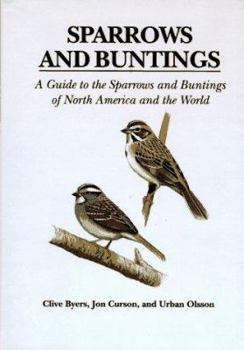Sparrows and Buntings: A Identification Guide
This new volume offers complete coverage of all 103 species of sparrows and buntings of North America, Europe, and Asia. Plumage of each species is illustrated in color. The text provides a detailed,... This description may be from another edition of this product.
Format:Hardcover
Language:English
ISBN:0395738733
ISBN13:9780395738733
Release Date:January 1995
Publisher:Houghton Mifflin
Length:256 Pages
Weight:2.26 lbs.
Dimensions:1.2" x 7.0" x 9.8"
Customer Reviews
1 rating
Solid, detailed reference with very good plates
Published by Thriftbooks.com User , 16 years ago
Basics: 1995, hardcover, 334 pages, 39 color plates, 110 species, range maps To clarify the title and subtitle, this book is written to cover the Emberizidae of only the Holarctic (North America, Europe, Asia). However, some species from Africa and South America are included if their genera is also found in the North (e.g., Aimophila, Junco, Zonotrichia, Emberiza). Not covered in this book are sparrows found only in the more southern areas (e.g., grassquits, bullfinches) and, the other New World buntings belonging to the family of the cardinal (e.g., grosbeaks, seedeaters, saltators, dickcissel, indigo bunting, etc.). Each of the 110 birds receives an average of two pages of text. The majority is on identification, description, and subspecies. This information is quite detailed and provides key points on separating one species from another. Additional sections on molt, measurements, taxonomy, voice, habits, status, habitat, and distribution are also given. Scores of black-and-white drawings are provided with the chapters to illustrate the finer points of feather patterns. The range maps are the weaker part of this book. Adding political boundaries for countries or US states would have been very helpful. I remember looking at the map for the Godlewski's Bunting and trying to discern if I was in or near the mapped area after looking at this bird in the field. One other criticism involves the section on geographical variations for the bird. Each subspecies is documented with the approximate ranges, which is useful. However, it takes extra research into many maps or atlases to figure out the boundaries around all the geographic locations mentioned in the text. It would have been remarkably simpler - for the reader - if these boundaries could have been included on the existing range maps. Other books in this series have included these subspecies ranges to great effectiveness. The color plates are very good and offer a variety of plumages for each bird. Birds with variable plumages such as Savannah, Fox, and Song Sparrows are nicely done. I wish the Timberline form of the Brewer's Sparrow could be displayed with more than just a forward-facing view of the upper breast and head. The patterning of the back is important. My only criticism of the plates is the arrangement of the birds across - or not - from the descriptive text. Too often, the numbers next to each bird appear to be in no order; consequently, forcing the reader to hunt across the page looking for bird 61b versus 61f. This book is necessary for birders with a deeper interest in the details of (northern) sparrows, especially for those who are able to bring photos back home to scrutinize against this book. This is not a field guide and this is not a book for birders trying to first learn their sparrows. I've listed several related books below... 1) Finches and Sparrows by Clement/Harris/Davis 2) A Guide to the Identification and Natural History of the Sparrows of the






